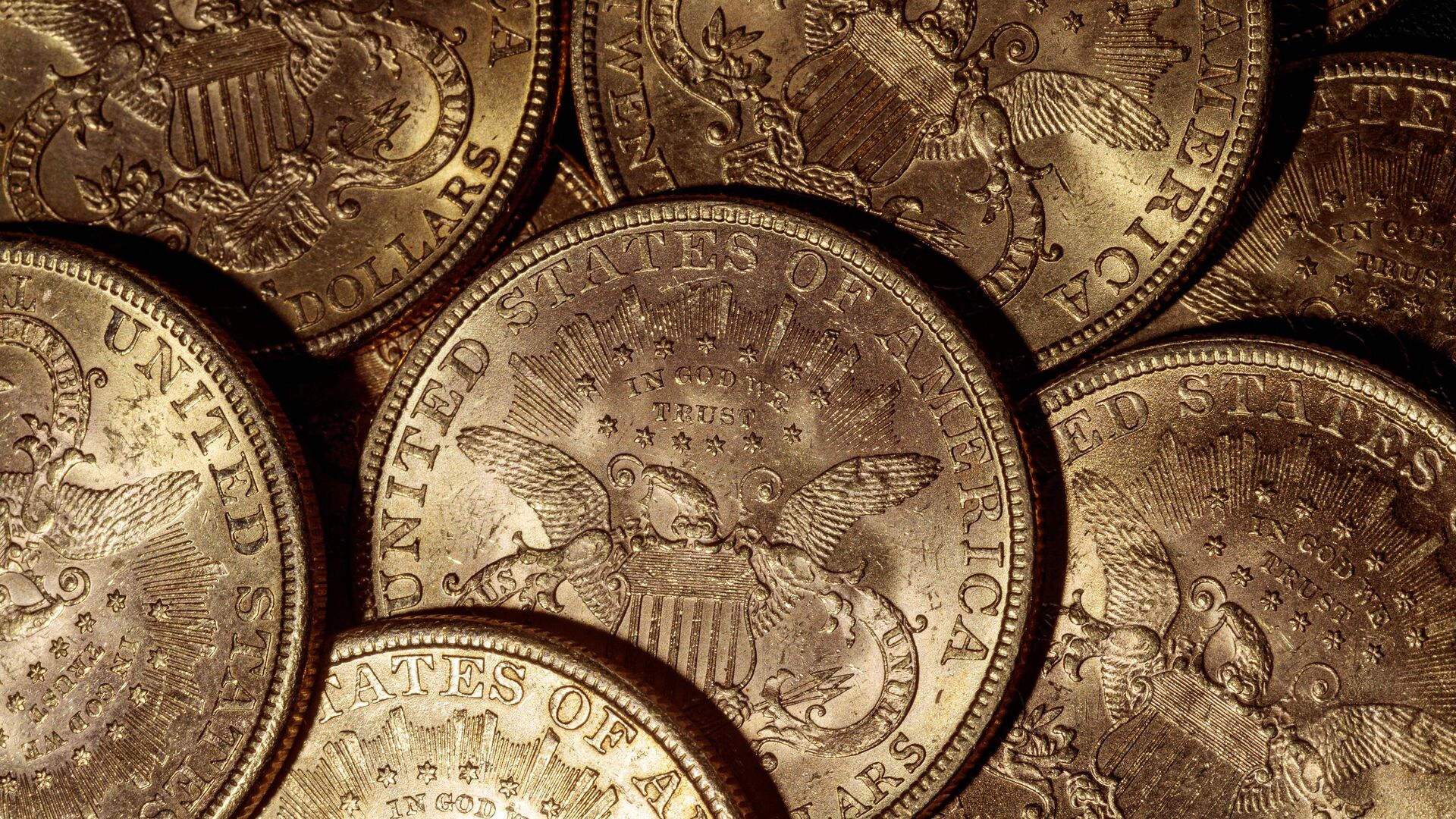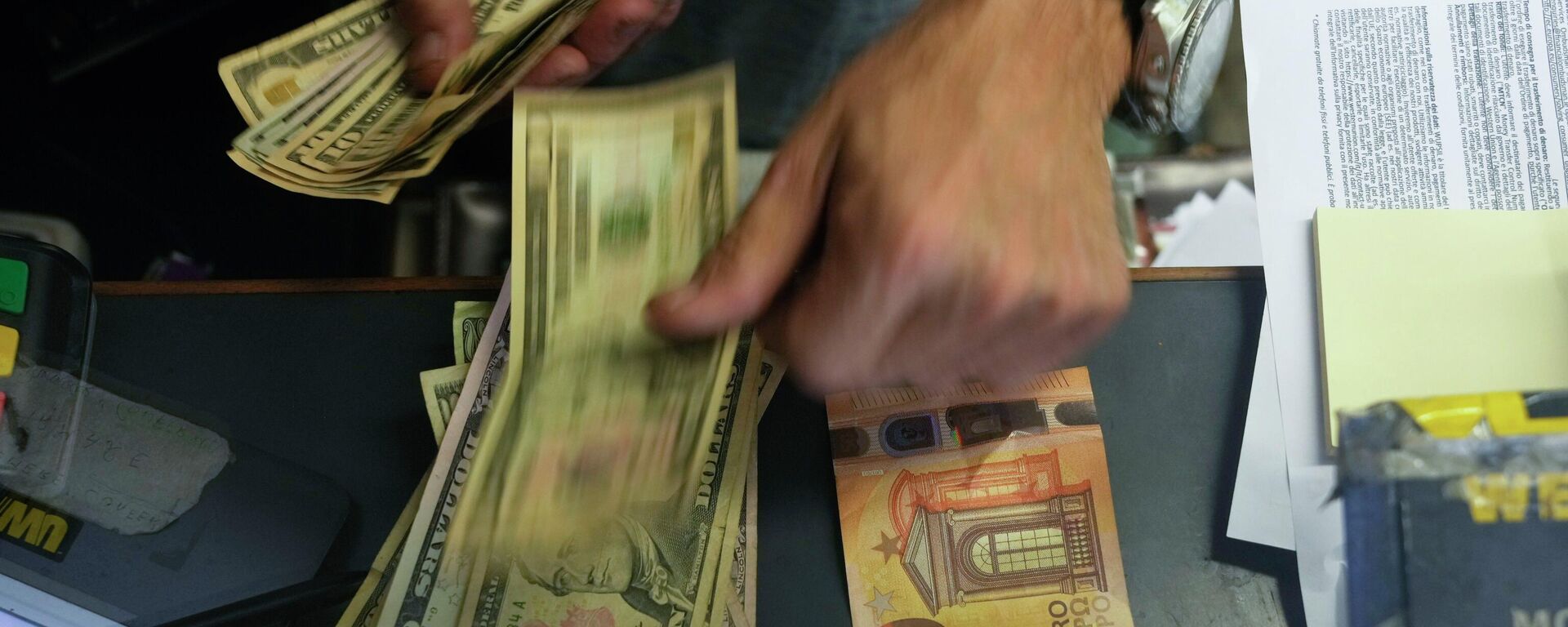https://sputnikglobe.com/20230420/why-did-roosevelt-kill-the-gold-standard-1109668899.html
Why Did Roosevelt Kill the Gold Standard?
Why Did Roosevelt Kill the Gold Standard?
Sputnik International
Until the 1930s, the United States dollar was backed by gold, with holders able head to their local bank and exchange a $20 bill for an ounce of the precious metal. That changed during the Great Depression. What prompted the decision? And what were its consequences?
2023-04-20T15:00+0000
2023-04-20T15:00+0000
2023-04-20T15:00+0000
economy
dollar
reserve currency
gold
franklin d. roosevelt
federal reserve
https://cdn1.img.sputnikglobe.com/img/07e7/04/13/1109668741_0:160:3072:1888_1920x0_80_0_0_4338f6c97d082fe73ca2bbbeaf59c956.jpg
Thursday marks the 90th anniversary of the April 20, 1933 proclamation by President Franklin Roosevelt (FDR) on the suspension of the convertibility of dollar notes into gold, the nationalization of private stocks of the precious metal, and the effective suspension of the gold standard, with dollars convertible into gold only in official international transactions from thereon out.Two weeks earlier, on April 5, 1933, Roosevelt issued an executive order requiring Americans to hand over all gold coins, bullion or bullion certificates they owned to their nearest Federal Reserve-affiliated bank. Anyone who failed to do so could face a hefty $10,000 fine (about $230k today), ten years in jail, or both.What Motivated FDR’s Decision?In his first-ever Fireside Chat address in March 1933, Roosevelt explained how, in the first weeks of his administration, the United States suffered a series of bank runs so severe that even “the soundest banks could not get enough currency to meet the demand.”On the advice of economist George Warren, FDR took the US off the gold standard, which, it was hoped, would curb market and banking volatility, ease restrictions on government spending, help restore America’s blighted agricultural sector and ultimately end the Great Depression that began with the stock market crash of October 1929.A year later, with the passage of the Gold Reserve Act of 1934, the president was given the power to determine by proclamation the value of America's gold relative to dollars. Roosevelt subsequently raised the statutory price of gold from $20.67 per troy ounce to $35, thereby devaluing the gold value of the dollar to 59 percent of the price set by the Gold Act of 1900, and devaluing Federal Reserve notes backed by the precious metal.The US moved to de-link its currency from gold pretty late relative to other major economies, with Britain, Germany and Austria, Australia, New Zealand and Canada doing so in 1931, and France, the Netherlands, Switzerland, Czechoslovakia, Belgium and other countries completing the process by the mid-1930s. The USSR was one of the last major economies to abandon gold, doing so in 1961 (although in practice, convertibility was possible only in foreign trade).The US hobbled along with its quasi-gold standard until August 15, 1971, when the Nixon administration, citing an economic crisis and rampant inflation, announced that the United States wouldn't convert dollars into gold at a fixed value any longer, thus nixing the gold standard altogether. President Ford lifted restrictions on the private purchase and ownership of gold in late 1974, after which it became a popular long-term hedge against inflation.Was FDR’s Gamble a Success?Yes and no. Going off gold, combined new infrastructure spending, the rise of new federal agencies, banking regulations, relief for the unemployed, and old age Social Security, did help the US recover from the Depression, with the country restoring its pre-crisis era GDP by the late 1930s. But it was ultimately World War II that put the Great Depression to an end for good, as millions of new defense related jobs were created, and the USA became the only major economy not directly impacted by the war. Pent up wealth and spending power helped to assure America's post-war boom, lasting over two decades.Over the long-term, the US has faced some of the downsides of the use of fiat currency, including inflation (one dollar in 1933 is equivalent to over $23 today) and out of control government spending. These impacts took many years to be felt by ordinary Americans, because for decades after the Second World War, the US was able to take advantage of the dollar’s de facto world reserve currency status to continue introduction trillions of additional dollars into the economy without suffering rampant, Wiemar Germany-style hyperinflation. However, a growing number of observers are now confident that the dollar’s place under the sun is coming to an end, which means the ability of the government to endlessly ramp up spending and debt may also be nearing its conclusion.Return of Gold?"We're in a situation with which it has become recognized worldwide with the failure of Silicon Valley Bank that US Treasuries, which were considered to be no risk investments, are not quite as 'no risk' as they were thought to be," says Dr. Linwood Tauheed, an associate professor of economics at the University of Missouri-Kansas City.What's new in the current situation, according to the professor, is that people are now coming to see gold not only as a hedge against inflation, "but also a hedge against the Federal Reserve's increasing of interest rates in order to fight inflation." In other words, the precious metal is coming to be viewed as a response "to any instability in the system, particularly instability that's being caused by the actions of the Federal Reserve, which is supposed to have the mandate of stabilizing the economy.""And so there's a flight from Treasuries that's occurring. People are saying, you know, do I invest in the Treasury Bond when if the Fed raises the interest rate, the face value of that bond, the resale value of that bond decreases? Or do I invest in gold, which supposedly will maintain its value in spite of what Treasuries and dollars do? So we're learning that there's an incoherence in the system even in regard to something like gold," Dr. Tauheed said.The academic warned that with the potential flight from Treasuries, the US government may find it more difficult to finance its debt and spending.Periods of instability like the one being experienced today could well see the return of restrictions on the private ownership of gold.At the international level too, efforts to turn to gold to escape the hegemony of the dollar or other fiat currencies can be fraught with extreme risk. Libyan leader Muammar Gaddafi proved as much, with his ambitious 'gold dinar' idea - a pan-African, gold-backed currency which would threaten the dollar and France's CFA franc, arguably one of the main reasons behind the brutal 2011 NATO operation to topple him.
https://sputnikglobe.com/20230413/paul-craig-roberts-washington-shot-itself-in-head-by-facilitating-de-dollarization-1109486264.html
https://sputnikglobe.com/20230419/us-economy-faces-stagflation-thanks-to-federal-reserve-interest-rate-hikes-1109654900.html
Sputnik International
feedback@sputniknews.com
+74956456601
MIA „Rossiya Segodnya“
2023
News
en_EN
Sputnik International
feedback@sputniknews.com
+74956456601
MIA „Rossiya Segodnya“
Sputnik International
feedback@sputniknews.com
+74956456601
MIA „Rossiya Segodnya“
dollar, gold-backed currency, gold-backed, gold, gold standard, reserve, federal reserve, united states, franklin roosevelt, fdr
dollar, gold-backed currency, gold-backed, gold, gold standard, reserve, federal reserve, united states, franklin roosevelt, fdr
Why Did Roosevelt Kill the Gold Standard?
Until the 1930s, the United States dollar was backed by gold, with holders able head to their local bank and swap a $20 bill and change for a troy ounce of the precious metal. That changed during the Great Depression. What prompted the US government's decision? And what were its consequences?
Thursday marks the 90th anniversary of the April 20, 1933 proclamation by President Franklin Roosevelt (FDR) on the suspension of the convertibility of dollar notes into gold, the nationalization of private stocks of the precious metal, and the effective suspension of the gold standard, with dollars convertible into gold only in official international transactions from thereon out.
Two weeks earlier, on April 5, 1933, Roosevelt issued an executive order requiring Americans to hand over all gold coins, bullion or bullion certificates they owned to their nearest Federal Reserve-affiliated bank. Anyone who failed to do so could face a hefty $10,000 fine (about $230k today), ten years in jail, or both.
What Motivated FDR’s Decision?
In his first-ever Fireside Chat address in March 1933, Roosevelt
explained how, in the first weeks of his administration, the United States suffered a series of bank runs so severe that even “the soundest banks could not get enough currency to meet the demand.”
On the advice of economist George Warren, FDR took the US off the gold standard, which, it was hoped, would curb market and banking volatility, ease restrictions on government spending, help restore America’s blighted agricultural sector and ultimately end the Great Depression that began with the
stock market crash of October 1929. A year later, with the passage of the Gold Reserve Act of 1934, the president was given the power to determine by proclamation the value of America's gold relative to dollars. Roosevelt subsequently raised the statutory price of gold from $20.67 per troy ounce to $35, thereby
devaluing the gold value of the dollar to 59 percent of the price set by the Gold Act of 1900, and devaluing Federal Reserve notes backed by the precious metal.
The US moved to de-link its currency from gold pretty late relative to other major economies, with Britain, Germany and Austria, Australia, New Zealand and Canada doing so in 1931, and France, the Netherlands, Switzerland, Czechoslovakia, Belgium and other countries completing the process by the mid-1930s. The USSR was one of the last major economies to abandon gold, doing so in 1961 (although in practice, convertibility was possible only in foreign trade).
The US hobbled along with its quasi-gold standard until August 15, 1971, when the Nixon administration, citing an economic crisis and rampant inflation, announced that the United States wouldn't convert dollars into gold at a fixed value any longer, thus nixing the gold standard altogether. President Ford lifted restrictions on the private purchase and ownership of gold in late 1974, after which it became a popular long-term hedge against inflation.
Was FDR’s Gamble a Success?
Yes and no. Going off gold, combined new infrastructure spending, the rise of new federal agencies, banking regulations, relief for the unemployed, and old age Social Security,
did help the US recover from the Depression, with the country restoring its pre-crisis era GDP
by the late 1930s. But it was ultimately World War II that put the Great Depression to an end for good, as millions of new defense related jobs were created, and the USA became the only major economy not directly impacted by the war. Pent up wealth and spending power helped to assure America's post-war boom, lasting over two decades.
Over the long-term, the US has faced some of the downsides of the use of fiat currency, including
inflation (one dollar in 1933 is equivalent to over $23 today) and
out of control government spending. These impacts took many years to be felt by ordinary Americans, because for decades after the Second World War, the US was able to take advantage of the dollar’s de facto world reserve currency status to continue introduction trillions of additional dollars into the economy without suffering rampant, Wiemar Germany-style hyperinflation. However, a growing number of observers are now confident that the dollar’s place under the sun
is coming to an end, which means the ability of the government to endlessly ramp up spending and debt may also be nearing its conclusion.
"We're in a situation with which it has become recognized worldwide with the failure of Silicon Valley Bank that US Treasuries, which were considered to be no risk investments, are not quite as 'no risk' as they were thought to be," says Dr. Linwood Tauheed, an associate professor of economics at the University of Missouri-Kansas City.
"And so we see that, in times of inflation, the idea is that people should buy gold because gold is going to maintain its value as dollars decrease in their purchasing power," Tauheed explained, speaking to Radio Sputnik's Garland Nixon on
The Critical Hour radio show Wednesday.
What's new in the current situation, according to the professor, is that people are now coming to see gold not only as a hedge against inflation, "but also a hedge against the Federal Reserve's increasing of interest rates in order to fight inflation." In other words, the precious metal is coming to be viewed as a response "to any instability in the system, particularly instability that's being caused by the actions of the Federal Reserve, which is supposed to have the mandate of stabilizing the economy."
"And so there's a flight from Treasuries that's occurring. People are saying, you know, do I invest in the Treasury Bond when if the Fed raises the interest rate, the face value of that bond, the resale value of that bond decreases? Or do I invest in gold, which supposedly will maintain its value in spite of what Treasuries and dollars do? So we're learning that there's an incoherence in the system even in regard to something like gold," Dr. Tauheed said.
The academic warned that with the potential flight from Treasuries, the US government may find it more difficult to finance its debt and spending.
Periods of instability like the one being experienced today could well see the
return of restrictions on the private ownership of gold.
At the international level too, efforts to turn to gold to escape the hegemony of the dollar or other fiat currencies can be fraught with extreme risk. Libyan leader Muammar Gaddafi proved as much, with his ambitious 'gold dinar' idea - a pan-African, gold-backed currency which would threaten the dollar and France's CFA franc,
arguably one of the main reasons behind the brutal 2011 NATO operation to topple him.




